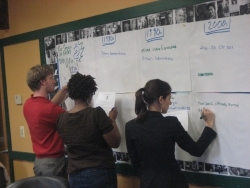Dec
1
2009

Frameworks for Determining Social Change Work and Civic Engagement
* Features of Movement Capacity Building for Nonprofits: How do organizations develop strategies and structures to facilitate the process of building momentum towards social change, and when do strategies and structures hurt this momentum? While both forms of capacity building are important, this tool points to some key differences between capacity building for organizational sustainability and capacity building for social justice and change.
* Building Organizational Capacity for Social Justice: Framework, Approach & Tools: Recognizing that much has been done in the general field of capacity building of the nonprofit sector, the National Gender and Equity Campaign (NGEC) began conducting extensive research to understand existing frameworks, tools and approaches in capacity building. The transformation framework and accompanying tools within this publication highlight NGEC’s intention to elevate the social justice movement by supporting the development of social justice organizations. (Framework developed byAsian Americans and Pacific Islanders in Philanthropy’s National Gender and Equity Campaign)
* Community Engagement Assessment Worksheet:This tool helps agencies take stock of their current level of community engagement by presenting a set activities and prompting agencies to think about how often they currently engage in each of these activities. The worksheet also helps agencies think about how they want to go about addressing this level of engagement and helps them think through their priorities in this area. (Developed by Margi Clarke and Emily Goldfarb, consultants to social change organizations.)
* Discussion Guide for Exploring Community Engagement: This is a series of small-group discussion questions for use during an agency retreat or extended meeting that offers a structured opportunity to explore the agency’s potential for community engagement work. (Developed by Margi Clarke and Emily Goldfarb, consultants to social change organizations.)
* Pathways for Individual and Collective Empowerment: This is a detailed diagram illustrating how collective involvement and individual development empower social justice actions within a community. (Developed by Margi Clarke and Emily Goldfarb, consultants to social change organizations.)
* Criteria for setting priorities in Policy/Program work: Based on an actual document developed by a service agency, this is an example of a set of criteria that an agency might set to determine which policy campaigns the agency should engage in. (Adapted by Developed by Margi Clarke and Emily Goldfarb, consultants to social change organizations.)
